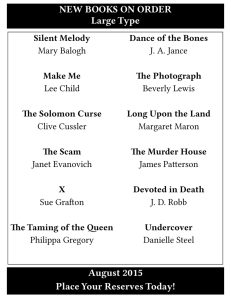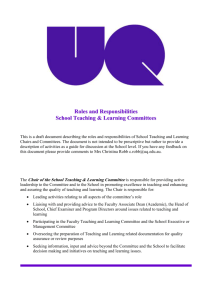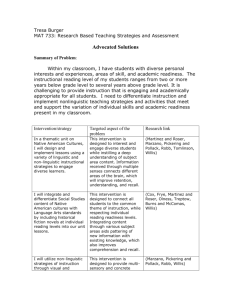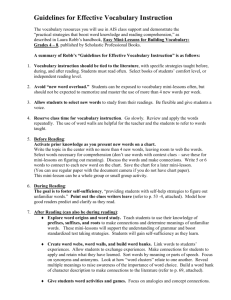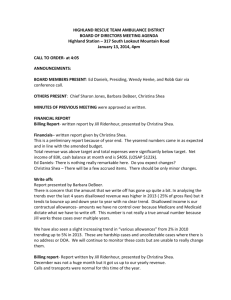Journal Reflection, Laura Robb
advertisement
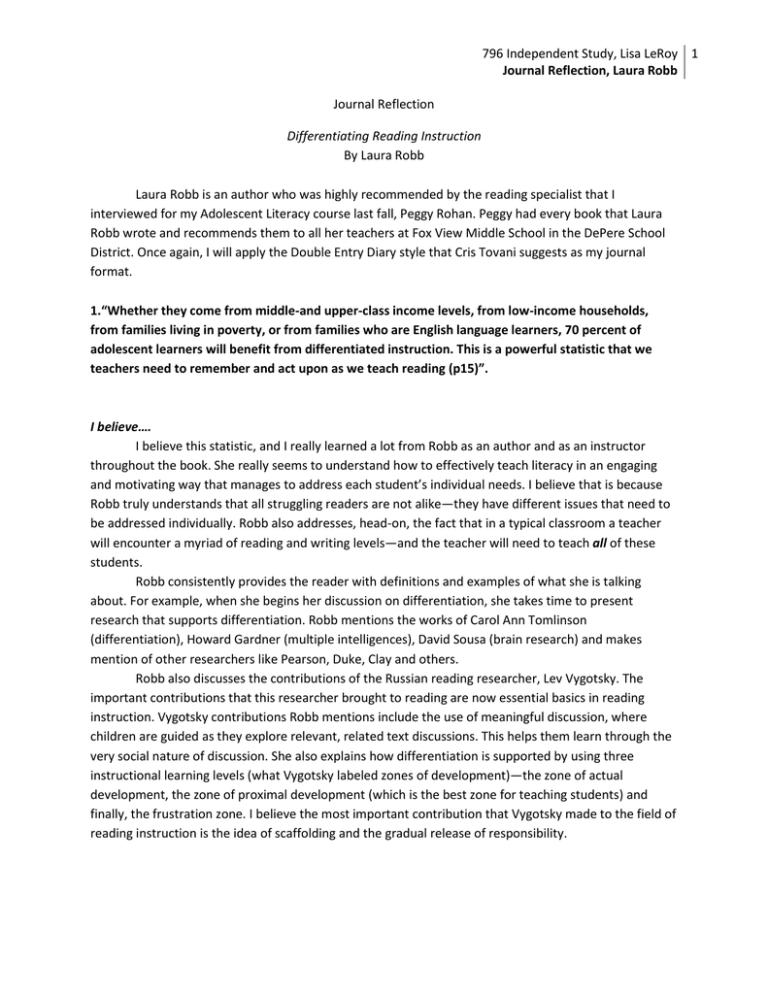
796 Independent Study, Lisa LeRoy 1 Journal Reflection, Laura Robb Journal Reflection Differentiating Reading Instruction By Laura Robb Laura Robb is an author who was highly recommended by the reading specialist that I interviewed for my Adolescent Literacy course last fall, Peggy Rohan. Peggy had every book that Laura Robb wrote and recommends them to all her teachers at Fox View Middle School in the DePere School District. Once again, I will apply the Double Entry Diary style that Cris Tovani suggests as my journal format. 1.“Whether they come from middle-and upper-class income levels, from low-income households, from families living in poverty, or from families who are English language learners, 70 percent of adolescent learners will benefit from differentiated instruction. This is a powerful statistic that we teachers need to remember and act upon as we teach reading (p15)”. I believe…. I believe this statistic, and I really learned a lot from Robb as an author and as an instructor throughout the book. She really seems to understand how to effectively teach literacy in an engaging and motivating way that manages to address each student’s individual needs. I believe that is because Robb truly understands that all struggling readers are not alike—they have different issues that need to be addressed individually. Robb also addresses, head-on, the fact that in a typical classroom a teacher will encounter a myriad of reading and writing levels—and the teacher will need to teach all of these students. Robb consistently provides the reader with definitions and examples of what she is talking about. For example, when she begins her discussion on differentiation, she takes time to present research that supports differentiation. Robb mentions the works of Carol Ann Tomlinson (differentiation), Howard Gardner (multiple intelligences), David Sousa (brain research) and makes mention of other researchers like Pearson, Duke, Clay and others. Robb also discusses the contributions of the Russian reading researcher, Lev Vygotsky. The important contributions that this researcher brought to reading are now essential basics in reading instruction. Vygotsky contributions Robb mentions include the use of meaningful discussion, where children are guided as they explore relevant, related text discussions. This helps them learn through the very social nature of discussion. She also explains how differentiation is supported by using three instructional learning levels (what Vygotsky labeled zones of development)—the zone of actual development, the zone of proximal development (which is the best zone for teaching students) and finally, the frustration zone. I believe the most important contribution that Vygotsky made to the field of reading instruction is the idea of scaffolding and the gradual release of responsibility. 796 Independent Study, Lisa LeRoy 2 Journal Reflection, Laura Robb 2. “Differentiation is a way of teaching; it’s not a program or a package of worksheets. It asks teachers to know their students well so they can provide each one with experiences and tasks that will improve learning (p13)”. I visualize…. I can easily visualize what Laura Robb is describing when she continues the above discussion from #1, explaining which elements are necessary in differentiated instruction. I also see how important interaction with students is to Robb—she seems to really know how to listen to them, and she is able to use what she hears and observes to help students read and write better. Robb lists the following elements as part of differentiated instruction: The most important element, I believe, is the element of assessment. The teacher needs to know his/her students in order to create appropriate and engaging instruction for them. In later chapters, Robb discusses methods of assessment that include not only standardized test results, but more importantly, student interviews and reaction sheets. She also discusses at some length the very important student-teacher conference, where a teacher and students can really interact. I can visualize very clearly meeting with my students after reading Robb’s description of how she conferences. I found her suggestions very practical and doable. I also really liked the forms she included in this book. They helped me visualize what she had in mind and also provided me with thoughts about how I could implement these ideas in my students. I can’t wait to try them in my classroom! It is crucial to understand that all your students are unique—they have their own special “literacy history,” to use Cris Tovani’s phrase. As the teacher, you need to use the above assessments and interviews to understand your class’s diversity. As a primary teacher, I forgot that, unfortunately, many secondary teachers don’t utilize the small group work format daily. This is one of the primary ways that students can create meaningful discussions that are so important to comprehension and textual understanding. In a classroom that is differentiated, the class is working on ideas and themes as opposed to the “required text.” Robb provides excellent examples of some of these themes when she shares unit plans. For example, one 5th grade unit is on the ocean while a 6th grade unit is on justice. The main emphasis when you work with themes isn’t the book, it is on problem solving. The last of Robb’s key lesson elements for differentiated instruction is one that, as an elementary teacher, I tend to take for granted: student choice. Within a primary classroom, you always block out time for kids to choose what they want to read and you create different ways for them to read their selections—do they want to buddy read? Or would they rather listen to the book on a CD? In the secondary classroom, with an emphasis on the required reading, I can see how this idea of choice might be forgotten. Yet, in a differentiated classroom, the element of choice would seem to be mandatory—especially if students have different reading levels. Robb points out that the instructor can “negotiate” with students about the books that they choose so that they are reading not only what is appropriate for them, but also what is motivating and engaging. 796 Independent Study, Lisa LeRoy 3 Journal Reflection, Laura Robb 3. “In my own school, and as I travel and work with schools around the country, I find that the culture of planning has waned (p49)”. I wonder… I wonder how a teacher can go into a class and just “wing it?” I find it frustrating—and even scary—to enter a classroom full of students not knowing what you want to do with them. When you read Robb’s book on differentiation, you know that to differentiate takes extra planning. This is particularly true if you are going to commit to ongoing assessment. Yet, isn’t this the best practice in literacy? I feel it is. I really appreciated the author’s attention to detail when she shared her unit plans as well as her whole group lesson and unit plans. When teaching in such a thematic way, the instructor really needs to know what direction he/she wants to go. I truly appreciated Robb’s question and answer section regarding unit planning, where she introduced the “10 frequently asked questions about differentiated whole class instructional reading.” I think it is important to understand that there is a difference between lessons/units designed for a small group versus those that are designed for the entire class. I also really liked that Robb covered how to plan a literacy block/class. That was very important for me as an elementary school teacher when thinking about teaching in a secondary classroom. I remember being bemused when I had to design a 50 minute literacy lesson, which is the amount of time an average middle and/or high school class meets, compared to the standard 90 minute literacy block prevalent in elementary schools. This book helped me fathom how I can teach effectively to a diverse group of learners at different school levels, and it gave me the nuts and bolts to help me do so. 4. “I recommend that you don’t send students’ journals home because many of them are not returned to class, and this becomes frustrating for me and for students (209-213)”. This reminds me of… This statement is indicative to me of an author who is actually a real life classroom teacher! I have, in the past, had logistical struggles implementing journaling in my classrooms. This section, where Robb discusses journals, how to organize them, and how to organize and support students’ responses to their journals was very enlightening. The above quote reminds me of a year when, right before report cards, I sent home students’ most current response journals. The parents/guardians were instructed to bring the journals back with them when they came for Parent/teacher conferences. Invariably, several parents remembered, but most forgot or simply neglected to comply. Next, I tried copying parts of the journals that I wanted to discuss, but I used up too much of my Xerox allotment doing so. I continue to look for effective ways to utilize journals in my class! I think the most important part of journaling is that it gives students a chance to process their own reactions to what they are reading and writing. But journals are also very important because they provide an opportunity for teachers to read what is on their students’ minds and to respond appropriately. Students need to know that teachers value their opinions, and that they are interested in what their students think. 796 Independent Study, Lisa LeRoy 4 Journal Reflection, Laura Robb In short, this book provided me with some new ideas, but it also inspired me to think about how to develop these ideas into strategies and potential techniques in my own classroom. Robb’s use of examples and the detail she offered was unique and special. It made the book particularly useful for a classroom teacher. I now understand why the reading specialist at Fox View Middle School recommended it so highly, and I concur with her high evaluation.
